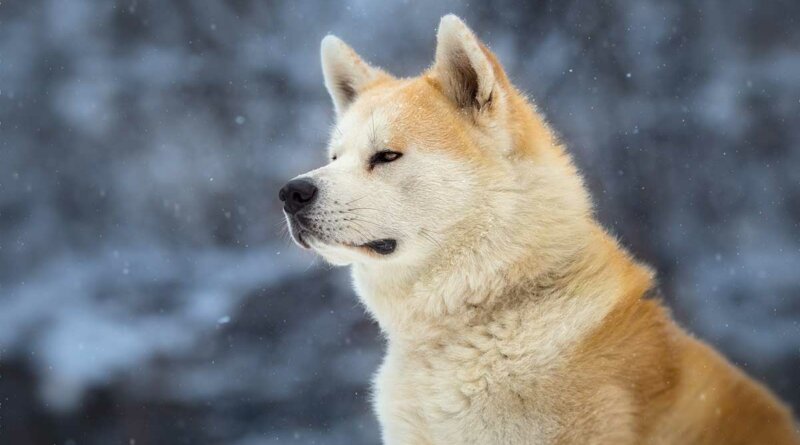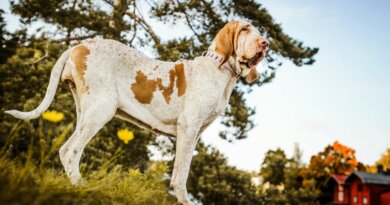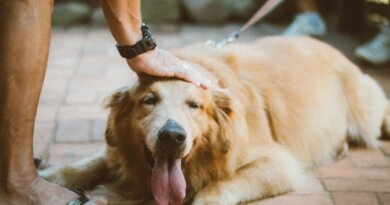What Kind Of Dog Is Hachi? (The Story, The Film, The Breed)
This post may contain affiliate links. We may earn money or products from the companies mentioned in this post.
There are many popular films about dogs, but one in particular really strikes a tender cord in any dog lover’s heart: Hachi: A Dog’s Tale.
After watching the 2009 drama film, many viewers have wondered: what kind of dog was Hachi? Hachi, short for Hachikō, was actually a Japanese Akitainu.
Hachikō was a fiercely loyal dog who would wait for his owner at the end of his work day at the train station.
Even after his owner died, Hachikō waited for a further 10 years until he died of old age.
The story of Hachikō embodies the spirit of the Japanese Akitainu dog breed. The breed is strong, courageous, and fiercely loyal to its owner.
Read on to find out more about the story of Hachikō and about the Japanese Akitainu as a breed.
Japanese Akitainu: Main Breed Characteristics
Height: 23 to 25 inches
Weight: 65 to 70 pounds
Lifespan: 10 to 12 years
Color: Brindle, red, white with white markings
Key Features: Loyal, strong, courageous, not good with other dogs, independent, heavy shedders, protective, difficult to train
What Is The Proper Way To Say Hachi’s Name?
The famous Japanese dog, Hachikō (also known as Hachi), was an Akitainu or Japanese Akita, which is a large Japanese dog breed known for its courage and fierce loyalty.
Let’s take a closer look at this breed’s interesting name. “Inu” in Japanese directly translates to “dog.”
Japanese speakers would often call them “Akita-ken,” as that is the more common pronunciation of the kanji (Japanese characters) for Akitainu.
Incidentally, “Hachi” in Japanese means eight. “Kō” is an honorific suffix given to men and was taken from mainland China.
Therefore, “Hachikō” loosely means “Sir Eight,” though of course, it is easy to see the obvious nickname for Hachikō would simply be shortened to Hachi.
What Is The Historical Story Of Hachiko?
In 1924 in Tokyo, Japan, a university professor, Hidesaburō Ueno, would often take the train from Shibuya Station to Tokyo Imperial University while accompanied by his dog Hachikō.
When he came back at the end of the workday, he was always greeted by Hachikō, who would leave the house on his own during the day and wait patiently for his owner prior to the train’s return at the station.
This goes to prove how intelligent the Japanese Akita is: Hachikō got the station, train platform, and time right every single day.
But one day, Ueno didn’t return – he had died while giving a lecture at the university.
Obviously, there was no way for Hachikō to know his best friend would never return home, and he dutifully went to the train station to await Ueno’s return.
Hachikō became known as the most loyal dog because every single day, he waited at Shibuya station for his owner to return, waiting in his customary spot at the time the train that would have brought his owner home arrived.
Incredibly, Hachikō continued this ritual until he himself died, not far from the very spot he would wait for his owner, almost 10 years later in 1939.
Prior to Hachikō’s death, one of Ueno’s students, Hirokichi Saito, who was familiar with the Akitainu breed, had noticed the dog at Shibuya station.
One day, he followed the dog to someone who told him of the relationship between Hachikō and Ueno.
Saito eventually wrote an article about how Hachi would faithfully wait for his master’s return–this article later appeared in a large Japanese newspaper.
Hachikō became known throughout Japan from then on, and he would often receive food and treats during his waits. Hachikō was held up as an example of absolute loyalty to family, a figure that everyone should try to be like.
After his death, a bronze statue of him was created and placed at the same train station in Shibuya where he would wait for his master.
His remains, however, were cremated, and his ashes were buried next to the remains of his owner, Hidesaburō Ueno, so that Hachikō could finally end his long wait.
Hachi: A Dog’s Tale
The 2009 movie Hachi: A Dog’s Tale is an adaptation of Hachi’s original story retold for a more modern American audience.
It is also an adaptation of the Japanese film Hachikō Monogatari (The Story of Hachikō). Whilst there are obvious differences in location and period, as well as additional subplots, the movie retains the core of the original story.
In the movie, a dog named Hachi accompanies his owner to the train station in the morning, returns to the same train station in the afternoon to wait for his owner, and repeats that routine until one day, his owner doesn’t return.
Hachi continues to faithfully wait every day at the right time at the same train station for his owner until his own death many years later.
The American film is fairly similar to the Japanese one, even adapting the same subplots and having Hachi run away so as to be able to carry on waiting for his owner.
What Is A AkitaInu Or Japanese Akita?
The Akitainu were famous and beloved in Japan and elsewhere even before the story of the world’s most loyal dog was told.
The breed was originally developed for hunting big game in Japan, such as deer, wild boars, and even bears.
As such, it’s not surprising to hear that the dogs of this breed are large, with strong muscles, thick bones, fiercely protective instincts, and an alert demeanor.
The Akitainu got their name, Akita, from the prefecture in Honshu (main island of Japan) of the same name where they were first bred.
Akitainu have always enjoyed a valued position in Japanese society, and they were initially only allowed to be owned by samurai.
During the Tokugawa era (warring states period) when the samurai were at the height of their power, the Akita were even considered to be the companion of the samurai, thereby marking them as the samurai among dogs.
What Does The Japanese Akita Look Like?
Everything about the Japanese Akita’s appearance evokes strength and power.
Males grow to a height of 26 to 28 inches at the shoulders, with females reaching 24 to 26 inches on average.
Their proportions for their size are different from other large dogs like Great Danes or greyhounds – the Akitainu have thick limbs with broad shoulders and chests and wide heads. They are often taller than they are long.
Japanese Akitas have a medium-length thick double coat that sheds almost constantly with a heavy shedding season twice a year.
They require daily brushing to reduce the amount of loose hair in their coats that can cause them to become matted and compacted.
Compacted coats cause hair loss and infection and are very painful for the affected dogs.
The Akitainu’s coat comes in a white, red, or brindle color with white markings on the chest, face, and belly.
They often have little black marks above their eyes which, amusingly, look like eyebrows.
The Akitainu has ears that stand up, which gives them a constantly alert look.
Their ears will need to be cleaned once a week to ensure no build-up of hair or wax causes an infection.
What Is The Japanese Akita’s Personality Like?
The Akitainu is a complex dog. It is fiercely loyal to its owner and incredibly protective; however, it is also very independent and not a very affectionate dog.
This makes it ideal for a single person or couple who want a dedicated guard dog who doesn’t require much fuss.
While the Akitainu breed is not aggressive or dangerous, Akitas are large and powerful dogs who do not like being played on, having their tails pulled, or being teased and would rather remove themselves from situations when there are small children around.
In terms of keeping an Akitainu with other dogs, the American Kennel Club definitely does not recommend it.
The Akitainu is a “lone wolf” and generally does not play well with other dogs. Akitas do not have a strong pack mentality and will vie to be the top dog in most situations.
Due to the Akitainu’s history as a big game hunter, they also have a high prey drive and will tend to chase smaller pets and children if they are provoked.
What Are The Japanese Akita’s Care Requirements?
The Akitainu became incredibly popular worldwide after the release of the westernized Hachikō movie, and many people rushed to get one without knowing exactly what they were getting themselves into.
It is important to know what kind of care your dog’s particular breed needs before bringing them home.
Exercise
The Japanese Akita needs a fair amount of daily exercise. They are hunting dogs, so they need to be able to engage with an interesting environment to get plenty of physical and mental stimulation.
In general, your Japanese Akita needs a minimum of an hour a day of exercise, whether it be physical or mental.
They love going for hikes, walks, and runs where they get to nose around in nature.
However, if you take them into areas where they will be around other dogs, remember to keep them on-leash and at your side, as their aforementioned high prey drive can create problems in these situations.
Akitainus are very intelligent and need adequate mental stimulation to avoid becoming bored and destructive.
Use puzzles and slow feeders to keep them engaged while you are not with them.
Health Concerns
As a large dog breed, the Akitainu is subject to the usual health concerns of hip dysplasia, luxating patellas, and other joint issues.
They are particularly susceptible to patella issues, as they are very tall dogs.
Take your Akitainu to the vet yearly to get them checked out. Even small, minor health issues can go unnoticed by you for a number of years until they become major concerns, while a vet will pick up the health issue much more quickly and be able to offer preventative care.
Training
Overall, the Japanese Akitainu is not a very trainable dog. Akitas are highly independent and prefer to do what they want, especially if they do not like your training style.
Avoid boring, repetitive tasks and engage them in what they are good at while using positive reinforcement.
Use their keen nose and hunting abilities to your advantage when training them.
However, keep in mind all of your training efforts may show very little at the end of the day because of this breed’s stubborn nature.
Consistency is key when training this breed.
FAQs About Hachikō And The Japanese Akitainu…
Why did the Japanese Akitainu nearly disappear?
The Akitainu was seen by many in Europe and America as an ideal breed for dog fighting.
They hunted elk, boar, and bears in the wild, so why not other dogs for money?
This led to many Akitainus being taken from Japan and crossbred with other dogs to develop ‘better’ fighting dogs.
At roughly the same time, World War II broke out, and the Japanese army was in need of fur to line their soldier’s coats.
The Akitainu’s fur was prized for its thick, soft texture. The government ordered these dogs to be surrendered.
Many owners also set their dogs free into the wild in hopes they would survive like their ancestors had based on their will and hunting ability.
Thankfully, some people were able to keep breeding pairs secret, and after several decades of careful breeding, the Akitainu breed was revived.
However, it now looked slightly different with some slight changes in its eye and ear shape because it was commonly crossbred with German shepherds.
Rolling Over On Hachi And The Japanese Akitainu…
Hachikō was a Japanese Akitainu who showed utter devotion and loyalty to his owner even after his death.
Hachikō’s story was immortalized in a Japanese movie and later an American retelling.
After watching the movie, many people flocked to pet stores trying to get their hands on a dog just like Hachi.
Many were greatly displeased to find the Japanese Akitainu, while fiercely loyal, was stubborn, hairy, and would rather do things on its own than cuddle.
If owning a dog like Hachikō is a dream for you, make sure you do all your research first and good luck! To sum up, the Japanese Akitainu’s key traits are:
- Loyal
- Independent
- Stubborn and somewhat difficult to train
- Highly intelligent
- High shedding coat
- Doesn’t do well with other dogs and small children
- Needs lots of exercise
Save To Pinterest
Top Picks For Our Puppies
- BEST PUPPY TOY
We Like: Calmeroos Puppy Toy w/ Heartbeat and Heat Packs – Perfect for new puppies. Helps ease anxiety in their new home. - BEST DOG CHEW
We Like: Bones & Chews Bully Sticks – All of our puppies love to bite, nip, and chew. We love using Bully Sticks to help divert these unwanted behaviors. - BEST DOG TREATS
We Like: Crazy Dog Train-Me Treats – We use these as our high-value treats for our guide dog puppies. - BEST FRESH DOG FOOD
We Like: The Farmer’s Dog – A couple months ago we started feeding Raven fresh dog food and she loves it! Get 50% off your first order of The Farmer’s Dog.
Check out more of our favorites on our New Puppy Checklist.




